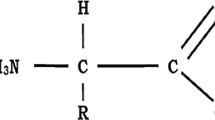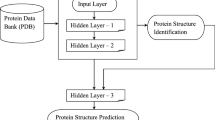Abstract
This is the continuation of our studies to use very basic information on enzyme to predict optimal reaction parameters in enzymatic reactions because the gap between available enzyme sequences and their available reaction parameters is widening. In this study, 23 features selected from 540 plus features of individual amino acid as well as a feature combined whole protein information were screened as independents in a 20-1 feedforward backpropagation neural network for predicting optimal pH in beta-glucosidase’s hydrolytic reaction because this enzyme drew attention recently due to its role in biofuel industry. The results show that 11 features can be used as independents for the prediction, while the feature of amino acid distribution probability works better than the rest independents for the prediction. Our study paves a way to predict the optimal reaction parameters of enzymes based on the amino acid features of enzyme sequences.





Similar content being viewed by others
References
Yan, S., & Wu, G. (2011). Applied Biochemistry and Biotechnology, 165, 856–69.
Yan, S., & Wu, G. (2012). Applied Biochemistry and Biotechnology, 166, 997–1007.
Jeng, W. Y., Wang, N. C., Lin, M. H., Lin, C. T., Liaw, Y. C., Chang, W. J., et al. (2011). Journal of Structural Biology, 173, 46–56.
Sticklen, M. (2006). Current Opinion in Biotechnology, 17, 315–319.
Alexov, E. (2004). European Journal of Biochemistry, 271, 173–185.
Garcia-Moreno, B. (2009). Journal of Biology, 8, 98.
Mitra, R. C., Zhang, Z., & Alexov, E. (2011). Proteins, 79, 925–936.
Talley, K., & Alexov, E. (2010). Proteins, 78, 2699–2706.
Scheer, M., Grote, A., Chang, A., Schomburg, I., Munaretto, C., Rother, M., Söhngen, C., Stelzer, M., Thiele, J. and Schomburg, D. (2011) Nucleic Acids Research, 39 (Database issue), D670-D676
Berrin, J. G., Czjzek, M., Kroon, P. A., McLauchlan, W. R., Puigserver, A., Williamson, G., et al. (2003). Biochemical Journal, 373, 41–48.
Tsukada, T., Igarashi, K., Fushinobu, S., & Samejima, M. (2008). Biotechnology and Bioengineering, 15, 1295–1302.
The UniProt Consortium (2010) Nucleic Acids Research, 38, D142–D148.
Burlingame, A. L., & Carr, S. A. (1996). Mass spectrometry in the biological sciences. Totowa: Humana.
Darby, N. J., & Creighton, T. E. (1993). Journal of Molecular Biology, 232, 873–896.
Zamyatin, A. A. (1972). Progress in Biophysics and Molecular Biology, 24, 107–123.
Cooper, G. M. (2004). The cell: a molecular approach (p. 51). Washington: ASM.
Kyte, J., & Doolittle, R. F. (1982). Journal of Molecular Biology, 157, 105–132.
Trinquier, G., Sanejouand, Y. H., & Hausman, R. E. (1998). Protein Engineering, 11, 153–169.
Dwyer, D. S. (2005). BMC Chemical Biology, 5, 2.
Chou, P. Y., & Fasman, G. D. (1978). Advance in Enzymology and Related Subjects in Biochemistry, 47, 45–148.
Wu, G., & Yan, S. (2006). Protein Peptides Letters, 13, 377–384.
Wu, G., & Yan, S. (2006). Acta Pharmacologia Sinica, 27, 513–526.
Wu, G., & Yan, S. (2008). Lecture notes on computational mutation. New York: Nova Science.
Wu, G., & Yan, S. M. (2002). Molecular Biology Today, 3, 55–69.
Yan, S., & Wu, G. (2010). Journal of Guangxi Academy of Sciences, 17, 145–150.
Demuth, H. and Beale, M. (2001) Neural network toolbox for use with MatLab. User’s guide. version 4.
MathWorks (1984–2001) MatLab—the language of technical computing. (version 6.1.0.450, release 12.1).
Chou, K. C. (2011). Journal of Theoritical Biology, 273, 236–247.
Sokal, R. R., & Rohlf, F. J. (1995). Biometry: the principles and practices of statistics in biological research (3rd ed., pp. 203–218). New York: W. H. Freeman.
Chan, P., & Warwicker, J. (2009). BMC Biology, 7, 69.
Feller, W. (1968). An introduction to probability theory and its applications (3rd ed., Vol. I). New York: Wiley.
Acknowledgments
This study was partly supported by Guangxi Science Foundation (0991006Z, 10-046-06, 2010GXNSFF013003, 11-031-11, and 12-071-10) and by Guangxi Academy of Sciences (11YJ24KY01). The authors wish to thank the Library of Guangxi Zhuang Autonomous Region for purchasing the book, Biometry.
Author information
Authors and Affiliations
Corresponding author
Electronic supplementary material
Below is the link to the electronic supplementary material.
ESM 1
(XLS 30 kb)
Rights and permissions
About this article
Cite this article
Yan, S., Wu, G. Prediction of Optimal pH in Hydrolytic Reaction of Beta-glucosidase. Appl Biochem Biotechnol 169, 1884–1894 (2013). https://doi.org/10.1007/s12010-013-0103-8
Received:
Accepted:
Published:
Issue Date:
DOI: https://doi.org/10.1007/s12010-013-0103-8




